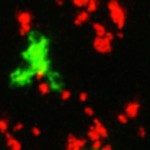Link to Pubmed [PMID] – 28878277
Link to DOI – 10.1038/s41598-017-09368-x
Sci Rep 2017 09; 7(1): 10659
CD4(+)CD8(+) “double positive” (DP) thymocytes differentiate into diverse αβ T cell sub-types using mechanistically distinct programs. For example, conventional αβ T cells develop from DP cells after partial-agonist T cell receptor (TCR) interactions with self-peptide/MHC, whereas unconventional αβ T cells, such as TCRαβ(+)CD8αα(+) intraepithelial lymphocytes (IELs), require full-agonist TCR interactions. Despite this, DP cells appear homogeneous, and it remains unclear how distinct TCR signalling instructs distinct developmental outcomes. Moreover, whether TCR signals at earlier stages of development, for example in CD4(-)CD8(-) double negative (DN) cells, impact on later fate decisions is presently unknown. Here, we assess four strains of mice that display altered TCR signal strength in DN cells, which correlates with altered generation of unconventional TCRαβ(+)CD8αα(+) IELs. FVB/n mice (compared to C57BL/6 animals) and mice with altered preTCRα (pTα) expression, both displayed weaker TCR signalling in DN cells, an inefficient DN-to-DP transition, and reduced contribution of TCRαβ(+)CD8αα(+) IELs to gut epithelium. Conversely, TCRαβ(+)CD8αα(+) IEL development was favoured in mice with increased TCR signal strength in DN cells. Collectively, these data suggest TCR signal strength in DN cells directly impacts on subsequent DP cell differentiation, fundamentally altering the potential of thymocyte progenitors to adopt conventional versus unconventional T cell fates.

